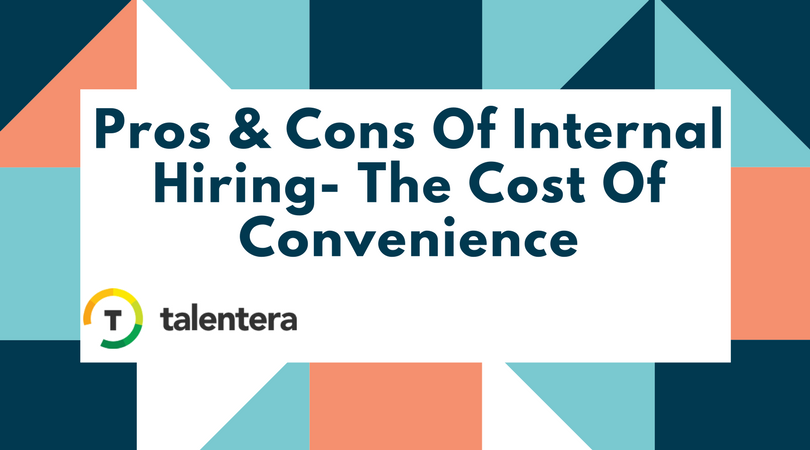Hiring decisions have a ripple effect; from company culture, diversity, productivity, efficiency, to budgets, there’s pretty much nothing that is spared from the impact of your one seemingly basic decision. So ultimately as a Hiring Manager with the weight of this responsibility on your shoulders- there’s really no room for errors (no pressure). You want to ensure that the company maintains consistent growth and a vibrant culture that is the subject of everyone’s awe and attention, but where can you find the most reliable talent to make this magic happen?
The answer to this question lies in recent research where it was concluded that internal hiring and referrals contribute to over 30% of the total talent acquisition activity. With more than a quarter of recruitment volume linked to either promoting existing talents or using employee recommendations to expand the workforce, there’s definitely a large preference of hiring managers towards picking up future employees from a network that is either familiar, or tried and tested.
There are pros and cons to this approach, hence we’ll take the liberty to scratch beneath the surface to identify the potential drawbacks of this approach in contrast to the benefits it delivers.
Pros:
1) Easy Integration: With internal hiring, companies have already invested resources into training, orientation and basically cultivating an understanding of performance expectations. This gives the employees an edge with excellent retained knowledge to get up-to-speed with their role pretty quick. This holds true even in the cases of referrals because the existing staff serve as your ambassadors to help their friends and referrals in eliminating any guess work; they already share all the guidance necessary to make the new joiner’s transition to the organization effortless.
2) Cost Savings: Working with agencies, advertising vacancies online, screening and scheduling interviews are a very time consuming and expensive process that takes up the majority of the HR department’s budget. Internal hiring and referrals work seamlessly to cut these costs, and remove decision related bottlenecks typically associated with tedious assessments. Even better- the existing talent and their referrals are always well aware of your pay scale, thus making them less likely to have unrealistic salary expectations in mind.
3) Better Morale: The company culture plays an instrumental role in ensuring staff retention alongside boosting employer branding; by establishing an environment that rewards excellence and top performance, staff will have a higher sense of loyalty due to the incentive of an exciting career path. By maintaining an open system where everyone has access to the same advancement opportunities, the chances of a promotion maintain a positive vibe, and encourage workforce engagement.
Cons:
1) Resistance to Change: Restricting hiring to internal talent means not allowing new employees to bring in fresh skills, ideas and perspectives to steer future business success. With an ever evolving business environment, changes in technical landscape, and tools that are constantly improving- the “tunnel vision” linked to prioritizing the promotion of the current workforce can hinder competitivity, productivity, and the company’s adaptability to remain on the forefront of thought and technological leadership.
2) Internal Tensions: With each vacancy attracting widespread interest, it’s easy to see why the applicant not selected will feel subjected to favouritism and bias from the decision makers. The competition to succeed, and not getting desired results, could lead to a sentiment of inadequacy. Thus, ensuring that your workforce has an understanding of the system’s transparency is pivotal to avoid cultivating an environment of unhealthy conflict and jealousy.
3) High Risk: Limiting options is a high risk decision because it involves blind-faith in your current employee to be able to do the task faster and better than any other external applicant. Unless the employee has been a part of your organization for a while with a proven track record, there are chances of them being able to kick the “fake it till you make it” mantra in gear because they have known you long enough to predict the answers you want to hear, in turn enabling them to use their years of accumulated insights to gain a misleading advantage over someone else genuinely better skilled to do the job.
Conclusion
When it comes to hiring, we’d recommend that you let statistics dictate which source delivers best value. Instead of putting all eggs (or in this case: vacancies) in one basket, you have to broaden your talent acquisition strategy to assess the potential that external sources can deliver.
This is not always easy especially for larger organizations; a resourceful ATS (applicant tracking system) like Talentera can unriddle this confusion for you by providing quantified comparisons of your top talent sources so you know where to invest your budget, for e.g boost your referral incentives, pump more money into online job boards, or expand your network of agencies to find your next superhero.
If you’re interested in learning more about best talent sourcing advice, don’t forget to check out our quick read here.
Before You Make Your Next Hiring Decision… Discover What Sets You Apart.
Subscribe to our newsletter to receive the latest Talentera content specialized in attracting top talent in critical sectors.








